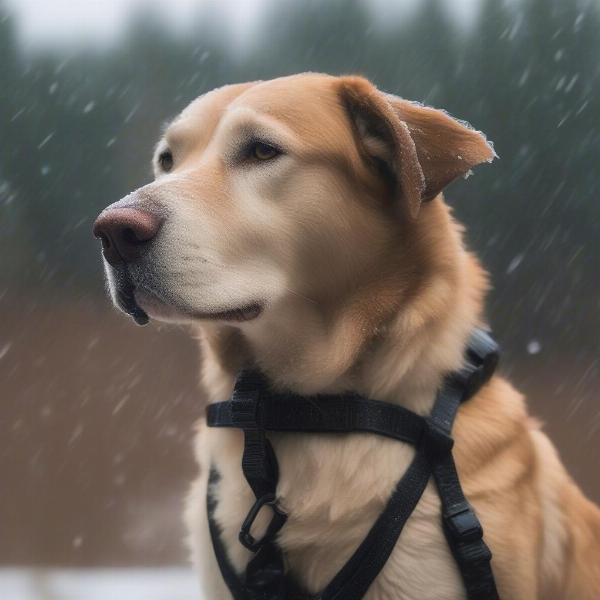A large breed dog harness is more than just a stylish accessory; it’s a crucial piece of equipment for managing your powerful companion safely and comfortably. Whether you’re navigating bustling city streets or enjoying a tranquil hike in the countryside, the right harness provides control, prevents pulling, and protects your dog’s delicate trachea. This comprehensive guide will help you choose the perfect large breed dog harness, ensuring both your dog’s well-being and your peace of mind.
Choosing the right harness for your large breed dog can feel overwhelming with the vast array of options available. Factors such as your dog’s breed, size, activity level, and even their temperament play a crucial role in determining the ideal harness type. This guide aims to simplify the process, providing you with the knowledge you need to make an informed decision and find the perfect fit. Let’s delve into the key considerations for selecting a large breed dog harness.
Types of Large Breed Dog Harnesses
Understanding the different types of harnesses is the first step. Each design offers unique benefits and drawbacks, making some more suitable for certain dogs and activities than others.
Front-Clip Harnesses
Front-clip harnesses attach to the leash at the dog’s chest. This design discourages pulling by gently steering the dog back towards you when they strain on the leash. They’re an excellent choice for training puppies or dogs prone to pulling.
Back-Clip Harnesses
Back-clip harnesses offer more freedom of movement and are generally more comfortable for relaxed walks. They are ideal for well-trained dogs who don’t pull excessively.
Dual-Clip Harnesses
Dual-clip harnesses offer the versatility of both front and back leash attachments. This allows you to switch between control and freedom depending on the situation, making them a great option for dogs in training or those who exhibit varying pulling tendencies.
Sizing and Fitting Your Large Breed Dog
Proper fit is paramount for both comfort and effectiveness. A harness that’s too tight can restrict movement and cause chafing, while one that’s too loose can slip off or become a safety hazard. Always measure your dog’s chest girth and refer to the manufacturer’s sizing chart before purchasing.
Measuring Your Dog for a Harness
To accurately measure your dog’s chest girth, wrap a flexible measuring tape around the widest part of their chest, just behind their front legs. Ensure the tape is snug but not restrictive.
Adjusting the Harness for Optimal Fit
Once you have the harness, adjust the straps to ensure a snug but comfortable fit. You should be able to fit two fingers between the harness and your dog’s body.
Material and Durability
Large breed dogs are strong and active, so durability is a key consideration. Look for harnesses made from robust materials like nylon or polyester webbing with reinforced stitching.
Weather Resistance
If you live in an area with frequent rain or snow, a water-resistant or waterproof harness is a must. This will keep your dog dry and comfortable during inclement weather.
 Waterproof Dog Harness for Large Breeds
Waterproof Dog Harness for Large Breeds
Special Considerations for Senior Dogs
Senior dogs may require harnesses with extra padding and support for arthritic joints. Look for harnesses with wider straps and soft, breathable materials.
What if my dog pulls excessively even with a large breed dog harness?
Sometimes, even with the right harness, a dog might continue to pull. In such cases, consider consulting a certified dog trainer for guidance on leash training techniques.
How often should I check the fit of my dog’s harness?
It’s a good idea to check the fit of your dog’s harness regularly, especially if they are still growing or gaining/losing weight. A well-fitting harness ensures comfort and safety.
Conclusion
Choosing the right large breed dog harness is an investment in your dog’s well-being and your shared adventures. By considering the factors discussed in this guide, you can confidently select a harness that provides comfort, control, and safety for your beloved companion. Remember to prioritize proper fit, durable materials, and a design that suits your dog’s individual needs and activity level.
FAQ
-
How do I know if a harness is too tight on my large dog? If you can’t fit two fingers between the harness and your dog’s body, it’s likely too tight.
-
What is the best type of harness for a dog that pulls? Front-clip harnesses are generally recommended for dogs that pull.
-
Can I leave a harness on my dog all the time? While some dogs can tolerate wearing a harness for extended periods, it’s generally recommended to remove it when not in use to prevent skin irritation.
-
Are dual-clip harnesses good for training? Yes, dual-clip harnesses are excellent for training as they offer the versatility of both front and back leash attachments.
-
What material is best for a large breed dog harness? Durable materials like nylon or polyester webbing with reinforced stitching are ideal.
-
How do I clean my dog’s harness? Most harnesses can be hand-washed with mild soap and water.
-
What should I do if my dog’s harness is damaged? Replace a damaged harness immediately to ensure your dog’s safety.
ILM Dog is a global pet website dedicated to providing expert advice on all aspects of dog care and upbringing. We offer resources on dog breeds, health, training, nutrition, grooming, activities, puppy care, senior dog care, travel, and products. From choosing the right breed to understanding their health needs, we’re here to support you every step of the way. For further assistance or personalized advice, reach out to our experts via email at [email protected] or call us at +44 20-3965-8624. ILM Dog is committed to helping you provide the best possible care for your canine companion.